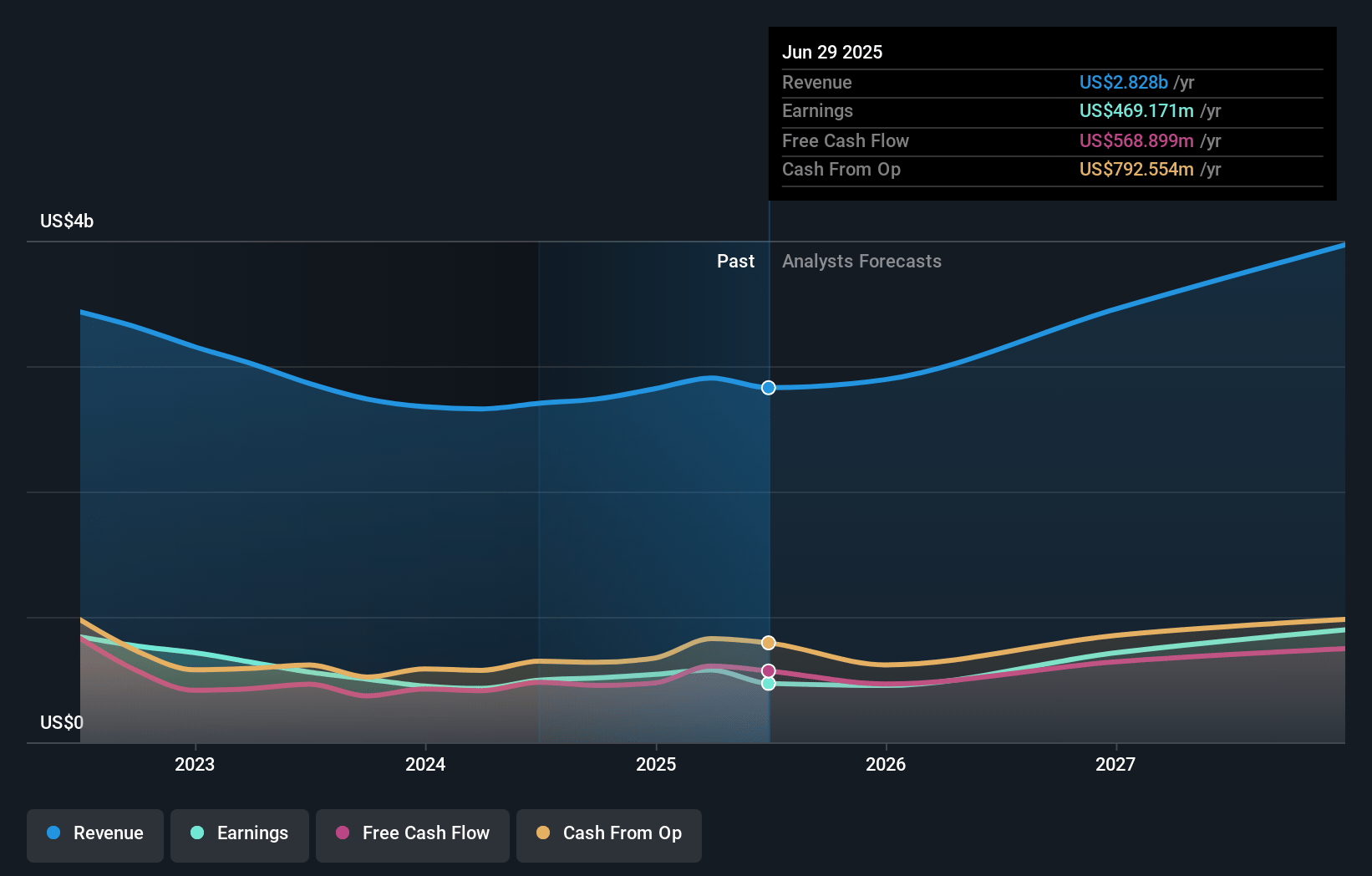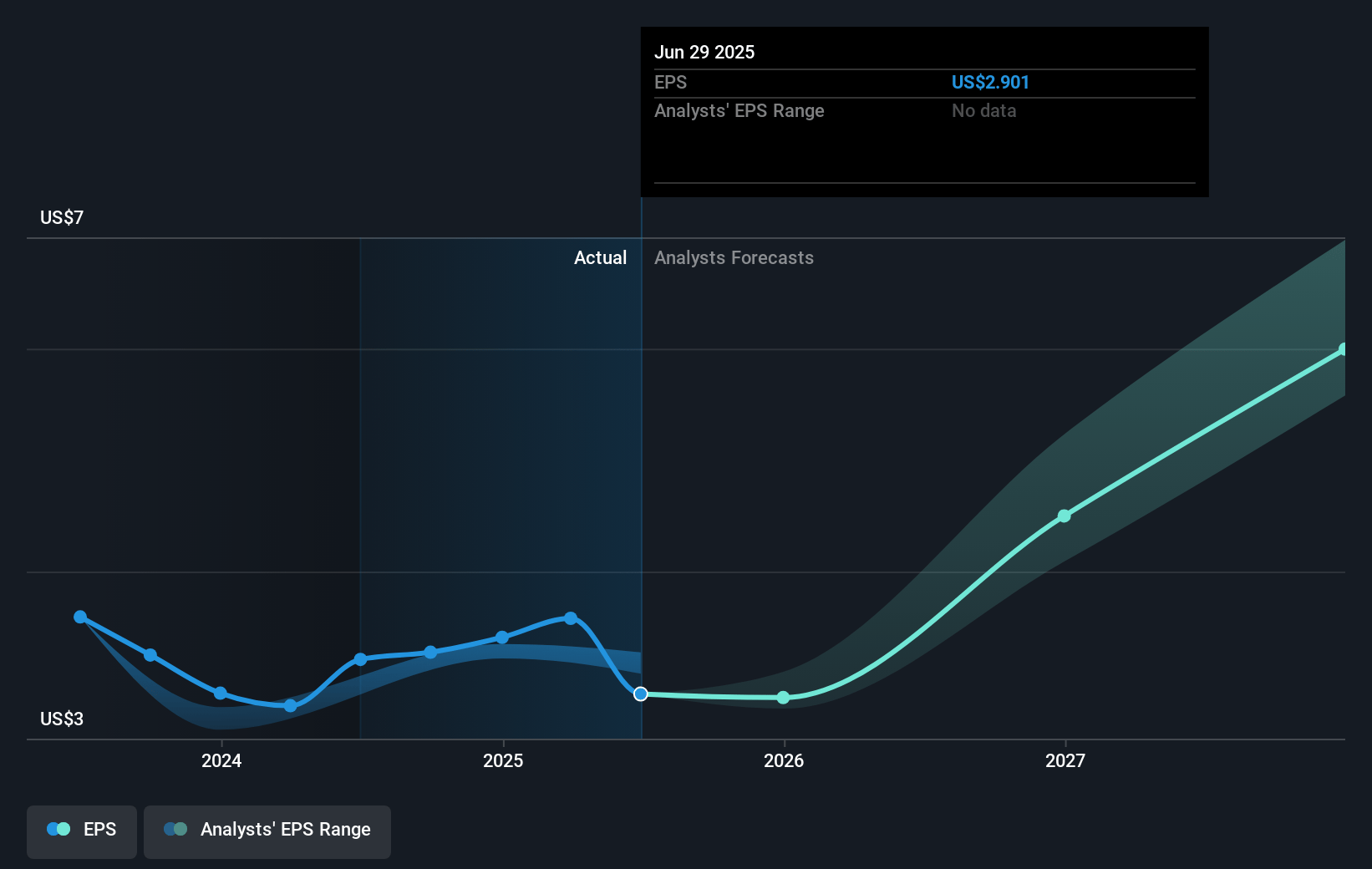Key Takeaways
- Modest growth in key sectors and a flat memory test market may limit Teradyne's revenue increase expectations.
- Restructuring in robotics reflects a focus on efficiency but could slow earnings, while dependence on few SOC clients poses revenue risk.
- Weakness in Industrial Automation and Robotics, alongside potential market softening and reliance on VIP customers, could impact future revenue growth and profitability.
Catalysts
About Teradyne- Designs, develops, manufactures, and sells automated test systems and robotics products in the United States, Asia Pacific, Europe, the Middle East, and Africa.
- Teradyne anticipates modest growth in mobile, automotive, and industrial sectors, leading to a more tempered recovery in the second half of 2025, which may limit revenue increase expectations below consensus.
- The gradual absorption of capacity in the HBM (High Bandwidth Memory) test market results in a forecasted flat memory test market in 2025, impacting overall revenue growth prospects.
- The robotics division continues to experience weak industrial automation market conditions, leading to lower-than-expected growth expectations in 2025, which constrains potential for improved net margins.
- The company’s restructuring efforts in robotics, aimed at reducing the breakeven revenue point, reflect a need for increased operational efficiency and could mean slower-than-expected earnings improvement.
- Teradyne’s growth in System on Chip (SOC) with low single-digit share gains is primarily driven by existing high-value cloud AI compute customers (VIPs). This concentrated client base exposes revenue to shifts within a few large accounts, presenting a risk to earnings forecasts.
Teradyne Future Earnings and Revenue Growth
Assumptions
How have these above catalysts been quantified?- This narrative explores a more pessimistic perspective on Teradyne compared to the consensus, based on a Fair Value that aligns with the bearish cohort of analysts.
- The bearish analysts are assuming Teradyne's revenue will grow by 7.1% annually over the next 3 years.
- The bearish analysts assume that profit margins will increase from 19.2% today to 27.2% in 3 years time.
- The bearish analysts expect earnings to reach $943.0 million (and earnings per share of $6.01) by about April 2028, up from $542.4 million today. The analysts are largely in agreement about this estimate.
- In order for the above numbers to justify the price target of the more bearish analyst cohort, the company would need to trade at a PE ratio of 22.0x on those 2028 earnings, up from 21.7x today. This future PE is lower than the current PE for the US Semiconductor industry at 22.3x.
- Analysts expect the number of shares outstanding to grow by 3.59% per year for the next 3 years.
- To value all of this in today's terms, we will use a discount rate of 8.82%, as per the Simply Wall St company report.
Teradyne Future Earnings Per Share Growth
Risks
What could happen that would invalidate this narrative?- Weakness in the Industrial Automation market and underperformance in Robotics could negatively affect future revenue growth, especially given the muted seasonality experienced in Q4 2024.
- Potential market softening for HBM test equipment demand in 2025, due to customers absorbing capacity with higher productivity tools, could flatten growth in the memory test segment and impact future revenues.
- The ongoing reliance on a small number of VIP customers in the Compute segment introduces potential volatility, with any client reduction or market shift impacting revenue projections.
- Expected digestion in the HBM tester market before potential recovery in 2026 creates uncertainty over short-term memory test market growth, potentially affecting revenues in the near term.
- Restructuring and integration efforts in Robotics increase operational risks, and delays in seeing improvements could persist, affecting profitability in this segment.
Valuation
How have all the factors above been brought together to estimate a fair value?- The assumed bearish price target for Teradyne is $90.63, which represents one standard deviation below the consensus price target of $110.02. This valuation is based on what can be assumed as the expectations of Teradyne's future earnings growth, profit margins and other risk factors from analysts on the more bearish end of the spectrum.
- However, there is a degree of disagreement amongst analysts, with the most bullish reporting a price target of $155.0, and the most bearish reporting a price target of just $69.0.
- In order for you to agree with the bearish analysts, you'd need to believe that by 2028, revenues will be $3.5 billion, earnings will come to $943.0 million, and it would be trading on a PE ratio of 22.0x, assuming you use a discount rate of 8.8%.
- Given the current share price of $73.16, the bearish analyst price target of $90.63 is 19.3% higher.
- We always encourage you to reach your own conclusions though. So sense check these analyst numbers against your own assumptions and expectations based on your understanding of the business and what you believe is probable.
How well do narratives help inform your perspective?
Disclaimer
AnalystLowTarget is an employee of Simply Wall St, but has written this narrative in their capacity as an individual investor. AnalystLowTarget holds no position in NasdaqGS:TER. Simply Wall St has no position in the company(s) mentioned. Simply Wall St may provide the securities issuer or related entities with website advertising services for a fee, on an arm's length basis. These relationships have no impact on the way we conduct our business, the content we host, or how our content is served to users. This narrative is general in nature and explores scenarios and estimates created by the author. The narrative does not reflect the opinions of Simply Wall St, and the views expressed are the opinion of the author alone, acting on their own behalf. These scenarios are not indicative of the company's future performance and are exploratory in the ideas they cover. The fair value estimate's are estimations only, and does not constitute a recommendation to buy or sell any stock, and they do not take account of your objectives, or your financial situation. Note that the author's analysis may not factor in the latest price-sensitive company announcements or qualitative material.







